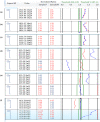Prenatal diagnosis of BACs-on-Beads assay in 1520 cases from Fujian Province, China
- PMID: 32767744
- PMCID: PMC7549593
- DOI: 10.1002/mgg3.1446
Prenatal diagnosis of BACs-on-Beads assay in 1520 cases from Fujian Province, China
Abstract
Background: The aim of this study was to evaluate the application of BACs-on-Beads (BoBs™) assay for rapid detection of chromosomal abnormalities for prenatal diagnosis (PND).
Methods: A total of 1520 samples, including seven chorionic villi biopsy samples, 1328 amniotic fluid samples, and 185 umbilical cord samples from pregnant women were collected to detect the chromosomal abnormalities using BoBs™ assay and karyotyping. Furthermore, abnormal specimens were verified by chromosome microarray analysis (CMA) and fluorescence in situ hybridization (FISH).
Results: The results demonstrated that the success rate of karyotyping and BoBs™ assay in PND was 98.09% and 100%, respectively. BoBs™ assay was concordant with karyotyping for Trisomy 21, Trisomy 18, and Trisomy 13, sex chromosomal aneuploidy, Wolf-Hirschhorn syndrome, and mosaicism. BoBs™ assay also detected Smith-Magenis syndrome, Williams-Beuren syndrome, DiGeorge syndrome, Miller-Dieker syndrome, Prader-Willi syndrome, Xp22.31 microdeletions, 22q11.2, and 17p11.2 microduplications. However, karyotyping failed to show these chromosomal abnormalities. A case of 8q21.2q23.3 duplication which was found by karyotyping was not detected by BoBs™ assay. Furthermore, all these chromosomal abnormalities were consistent with CMA and FISH verifications. According to the reports, we estimated that the detection rates of karyotyping, BoBs™, and CMA in the present study were 4.28%, 4.93%, and 5%, respectively, which is consistent with the results of a previous study. The respective costs for the three methods were about $135-145, $270-290, and $540-580.
Conclusion: BoBs™ assay is considered a reliable, rapid test for use in PND. A variety of comprehensive technological applications can complement each other in PND, in order to maximize the diagnosis rate and reduce the occurrence of birth defects.
Keywords: BoBs™; CMA; FISH; PND; karyotyping; microdeletions; microduplications.
© 2020 The Authors. Molecular Genetics & Genomic Medicine published by Wiley Periodicals LLC.
Conflict of interest statement
The authors declare that no conflict of interest was present that can be perceived as having prejudiced the impartiality of the research reported.
Figures




References
-
- Callaway, J.L. , Shaffer, L. G. , Chitty, L. S. , Rosenfeld, J. A. , & John, A. C. (2013) The clinical utility of microarray technologies applied to prenatal cytogenetics in the presence of a normal conventional karyotype: a review of the literature. Prenatal Diagnosis, 33(12), 1119‐1123. 10.1002/pd.4209 - DOI - PMC - PubMed
-
- Chen, C.‐P. , Ko, T.‐M. , Chern, S.‐R. , Wu, P.‐S. , Chen, Y.‐N. , Chen, S.‐W. , … Wang, W. (2016). Prenatal diagnosis of low‐level mosaicism for trisomy 2 associated with a favorable pregnancy outcome. Taiwanese Journal of Obstetrics and Gynecology, 55(2), 303–304. 10.1016/j.tjog.2016.03.001 - DOI - PubMed
Publication types
MeSH terms
LinkOut - more resources
Full Text Sources
Medical

